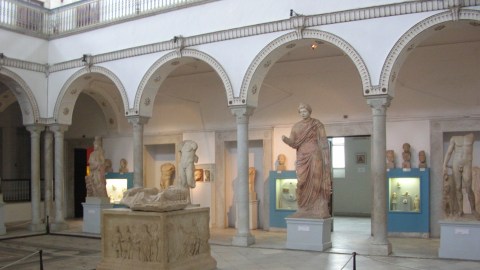Death at the Museum: Tunisia, ISIS, Civilization, and Survival

The attack at the Bardo National Museum in Tunis, Tunisia, on March 18, 2015, was an attack on civilization itself. Not just Tunisian civilization or Western civilization or Islamic civilization or Christian civilization — ALL civilization. ISIS may not have been directly involved in the Tunisian attack, but its iconoclastic, its “year zero” philosophy certainly was present. The fact that these attackers targeted tourists seeking out ancient civilizations rather than the artifacts of those ancient civilizations makes this latest tragedy even more chilling. The Bardo National Museum attacks may one day emerge as the first battle in the ultimate fight for civilization’s survival.
When terrorists struck the Bardo National Museum this week, they left at least 19 dead: including two locals from Tunisia, five from Japan, four from Italy, two from Colombia, two from Spain, and one each from Australia, Poland, and France. (One victim’s nationality was not disclosed.) The nationalities of the 44 injured also spread across the globe. Such an attack on tourism at one of Tunisia’s main tourist attractions marks a focused attack on the Tunisian economy itself, which is based heavily on tourism. The attacks may have been motivated by the recent death in battle of Ahmed Al-Rouissi, a Tunisian ISIS leader in Libya, and/or by major confiscations of weapons from Tunisian jihadi groups by the Tunisian government. Tunisia and other countries fighting ISIS and similar groups have seen and even come to expect retaliatory attacks, but the Bardo attacks represent a wholly different approach from terrorists, who usually choose more clearly political or military targets.
Tunisia itself stands as a testament to the possibility of peaceful change in the Islamic world. Tunisia’s 2011 “Jasmine Revolution,” part of the wider “Arab Spring,” began with the ouster of President Zine El Abidine Ben Ali (who bloodlessly, but unelectedly replaced his ill predecessor in 1987 in a “medical coup”) and concluded with the democratization of the Tunisia with free, democratic elections of center-left and left-leaning parties committed to the modernization and tolerance.
One powerful symbol of the Tunisian revolution’s effects is the Bardo National Museum itself. Originally a 19th-century bey’s palace, the Bardo National Museum was called before the 2011 revolution Museum Alaoui, after the then-reigning bey (the Turkish title for a chieftain). The name was new, but the art inside remained the same. Decades of excavations of the North African country that once was classical Carthage, the BCE power that vied for power with the grandeur that was Greece and the glory that was Rome (but eventually lost), unearthed riches for the modern imagination to wonder at. The conquering and often colonizing winners left behind treasures and influences that you can see easily throughout the Bardo National Museum, including in the “Carthage Room” (shown above). Tunisia’s one of those many amazing sites in Northern Africa and the Middle East where ancient cultures clashed and cross-pollinated in interesting ways.
Such interaction makes the intolerance behind the attacks even sadder. “Today’s murderous assault targeted not only tourists and Tunisians but also the tolerant and rights-respecting society that Tunisians have been struggling to build,” Human Rights Watch’s Eric Goldsteinremarked. But this attack falls in line with the larger iconoclasm of ISIS. The Guardian’s Ian Black neatly outlined the religious reasons behind ISIS’ attack on cultural sites within their control. “Destroying some of the world’s greatest archaeological and cultural treasures is something that flows from a fanatically purist interpretation of Sunni Islam as first laid down in seventh-century Arabia and revived more than a millennium later,” Black explains. That misinterpretation thus puts not just Western cultural sites on the hit list, but also “90 percent of Islamic monuments, holy places, tombs, and mausoleums in the Arabian peninsula … on the grounds that they were ‘polytheistic,’” including, amazingly, the grave of the prophet Muhammad’s wife and his descendants, including his daughter, Fatimah. This isn’t just iconoclasm — it’s large-scale erasure with the goal of turning back the clock to some mythic, pure starting point, a true “year zero” in the sense not only of beginnings, but also of emptiness. In addition to sculpture and other visual art, ISIS burns musical instruments and torches libraries with the same eradicating end in mind.
But as troubling as targeting the objects of civilization feels, I find the targeting of those who appreciate those objects even more threatening. Yes, on a purely “let’s hurt them where they live” level, the Bardo National Museum attack involved economic elements, but on the larger scope of ISIS-style terrorism, striking fear into the hearts of those who consume and patronize culture helps progress the “year zero” scheme. Civilization exists in objects, of course, but it endures in the minds, hearts, and imaginations of those who study them. Cutting off that curiosity, especially in those motivated to travel to places such as Tunisia, burns bridges to the past as powerfully as burning any museum or library. Thousands of Tunisians took to the streets the day after the attacks both to protest the violence and to affirm their commitment to democracy and the continuation of civilization. Considering how many different countries had citizens involved in the bloodshed, it will be interesting to see how many other nations do the same. Je suis Bardo?
Of all the treasures of the Bardo National Museum, perhaps the finest is their world-class collection of Roman mosaics, the beautiful images composed of tiny colored stones called tesserae. Just as you need to need to step back from these mosaics to allow those tiny tesserae to form a larger picture, we all need to step back from the individual attacks on Tunisia and ISIS-controlled lands to see the bigger picture of an all-out attack on civilization. Some will want to paint this conflict as Western versus Islamic civilization, with all the religious overtones that involves, but, as pointed out above, this struggle is literally ISIS versus the world — the entire world outside their narrow definition of Islam, which includes at least 90 percent of Islamic cultural sites and who knows what percentage of Islamic faithful. Innocent people gave their lives yesterday because they wanted to experience a part of our shared, global heritage. If civilization will survive ISIS’ “year zero” plan, maybe we should all start seeing civilization and its cultural manifestations not as a luxury, but as a matter of life and death.
[Image: Carthage Room, Bardo National Museum, Tunis, Tunisia. Photo by Bernard Gagnon. Image source:Wikipedia.]
[Please follow me on Twitter (@BobDPictureThis) and Facebook (Art Blog By Bob) for more art news and views.]





